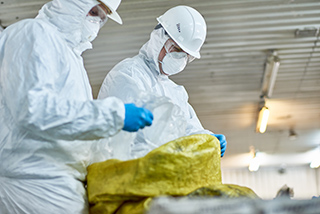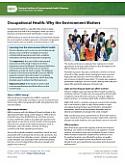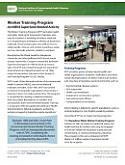Introduction

Workers' Health
Workers may be exposed to hazards in many types of jobs. These hazards may include chemical agents and solvents, heavy metals such as lead and mercury, physical agents such as loud noise or vibrations, and physical risks such as electricity or dangerous machinery. The field of occupational health identifies and helps control these hazards to protect workers’ health.
What is NIEHS Doing?
The Worker Training Program (WTP) - Under the Superfund Act of 1986, NIEHS initiated WTP as a training grants program to assist workers who handle hazardous waste or respond to emergency releases of hazardous materials. WTP works with organizations across the country and has reached more than 3.5 million people with high-quality, targeted training. Workers come from a variety of sectors, and some WTP programs address the unique needs of emergency responders. WTP has six major training programs plus a National Clearing House for Worker Safety and Health Training.
- The Hazardous Waste Worker Training Program provides occupational safety and health training for workers who may be engaged in activities related to hazardous waste removal, containment, or chemical emergency response.
- The Environmental Career Worker Training Program has provided job training to roughly 12,000 people in underserved communities, teaching the skills necessary to obtain employment in environmental cleanup and construction fields.
- The HAZMAT Disaster Preparedness Training Program supports the development and delivery of training to prepare workers for hazardous material and debris cleanup needed after natural and man-made disasters.
- The Small Business Innovation Research E-Learning for HAZMAT Program provides grants to organizations to develop e-learning products, such as virtual reality and handheld device applications.
- The NIEHS/Department of Energy (DOE) Nuclear Worker Training Program provides safety and health training for hazardous material handlers and waste workers at DOE facilities. Many of these workers are engaged in the cleanup of closed nuclear weapons facilities, among the most radioactive sites in the world. Workers deal with radioactive wastes, spent nuclear fuel, excess plutonium and uranium, and contaminated soil and groundwater.
- The Infectious Disease and Biological Hazards Training develops and delivers programs on the prevention of occupational exposure to infectious diseases, such as COVID-19, Ebola, Zika, and highly contagious flu. A variety of occupations are served.
- The National Clearinghouse for Worker Safety and Health Training is a national resource for hazardous-waste worker curricula, technical reports, and weekly news on hazardous materials, waste operations, and emergency response. Funded by WTP, the National Clearinghouse provides technical assistance to program staff and awardees, and the public.
NIEHS Partnerships for Environmental Public Health (PEPH) involves researchers, public health officials, and communities working together to use research to improve health.
National Toxicology Program (NTP) - Workers may encounter a range of chemicals while doing their jobs. Chemicals like asbestos, bisphenol A (BPA), pesticides, and heavy metals are known to cause adverse health effects. NIEHS and NTP research many of these agents and their potential effects on animals and humans.
The NIH Disaster Research Response Program (DR2) is a national framework for research on the medical and public health aspects of disasters and public health emergencies. The DR2 website, provided by NIEHS and the National Library of Medicine, supports disaster science investigators by offering data collection tools, research protocols, disaster research news and events, and more.
The Agricultural Health Study began in 1993 and has included more than 89,000 farmers and their spouses in Iowa and North Carolina. NIEHS partners with the National Cancer Institute in this study. Researchers look at links between the agricultural environment and the health of farmworkers. Farmers have unique work-related exposures such as herbicides and insecticides, animals, and dusts, as well as risks from operating machinery. So far, more than 38 pesticides have been evaluated to determine whether the farmers who use them have a greater chance of developing cancer.
The Gulf Long-term Follow-up Study is larger and has been conducted for a longer time than research on other oil spills. The purpose of the study is to examine the health of persons involved in the response and clean-up efforts. Its defining feature is the level of detail obtained on potential oil-spill exposures and the extensive efforts made to characterize the exposures of those who helped the clean up following a major environmental, and potential public health, disaster. A special issue of the journal Annals of Work Exposures and Health, published in April 2022, has 14 articles of research findings from the study. Readers may glean information on how to approach such studies in the future and how to prepare plans to reduce harmful exposures for clean-up workers. Because spills continue, learning from the Deepwater Horizon response is important. Research will continue under this study with plans to follow these workers and note any other health effects that are associated with exposures from the oil spill cleanup.
The Occupational and Inhalation Exposures Program studies airborne exposures in a variety of workplace settings. Health effects studied range from mild respiratory conditions to progressive, irreversible diseases, and even fatalities. Substances studied include asbestos, α-pinene, and mold.
Further Reading
Stories from the Environmental Factor (NIEHS Newsletter)
- Cumulative Effect of Disasters Takes Toll on Cleanup Workers (April 2025)
- Worker Training Program Spotlights Hazards in Emerging Industries (December 2024)
- Brazil Coffee Worker Study Examines Fungicide Effects, Tests Predictive Tools (December 2024)
- Environmental Career Worker Training Program Improves Lives (July 2024)
- Advisory Council Considers Military Exposures, Community-based Research (July 2024)
- Worker Training Program Strives to Protect Those Most Vulnerable (July 2024)
- Worker Training Program Yields Substantial Return on Investment (December 2023)
- Recovery-friendly Workplaces on the Rise, Despite Limited Resources(September 2023)
- Assessing the Long-term Neurological Impact of Oil Spill Cleanup(August 2023)
- “Building Pathways” Fosters Diverse Pipeline in Construction Careers(December 2022)
- GuLF Study Describes Inhalation, Dermal Exposures for All Oil Cleanup Job Roles(June 2022)
- Webinar Explores Sailors’ Mental Health During COVID, How Pollutants Can Affect the Microbiome(June 2022)
- Program Trains Radiological Control Technicians, Protects Their Safety(April 2022)
- Pesticide Exposure on Thai Farms Mapped by NIEHS-funded Scientists(February 2022)
- NIOSH 50th Anniversary Honored by National Toxicology Program (April 2021)
Printable Fact Sheets
Press Releases
- Oil Spill Cleanup Workers More Likely to Have Asthma Symptoms (August 17, 2022)
Podcasts
- Protecting Firefighter Health (2023) - Jeff Burgess, M.D., professor in the college of public health at the University of Arizona, has been a leader in the field of firefighter health and safety research for more than 30 years. Burgess discusses the health risks of firefighting and shares best practices to reduce occupational exposures and improve firefighter health.
- Combining Technology and Training to Protect Workers’ Health (2023) - Cesar Bandera, Ph.D., and Mitchel Rosen, Ph.D., both NIEHS grant recipients, are using cell phone-based technologies to enhance health and safety training for hazardous materials workers. When hazardous materials are spilled or released, specially trained workers must respond to minimize the health and safety risks posed to people, communities, and the environment.
Additional Resources
- About the National Institute for Occupational Health and Safety (NIOSH) – This agency of the Centers for Disease Control and Prevention develops new knowledge in the field of occupational safety and health and transfers that knowledge into practice.
- Occupational Health – A compendium from MedlinePlus, which links to health information from the National Institutes of Health and other federal government agencies.
- WTP Training Highlights and Success Stories – Read stories about people helped by WTP on NIEHS’ website.
This content is available to use on your website.
Please visit NIEHS Syndication to get started.



